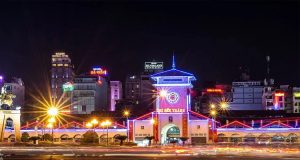Sai Gon
Ho Chi Minh city, formerly known as Sai Gon, is the largest city in Vietnam. It was the capital of the French protectorate of Cochinchina (1862- 1954) and of the south Vietnam (1954-1975). The city lies along the Sai Gon river to the north of the Mekong River Delta, about 80 km to the sea. The commercial center of Cho Lon lies towards the west of Ho Chi Minh city. The population with more than 9 million people cover over 2,095 km2. With the favorable climate for the whole year round and the convenient access from the other countries by air, by road, and by sea, Ho Chi Minh city is a busy and dynamic metropolitan.
History
Sai Gon’s History
In 1859 Sai Gon was captured by the French and in 1892 it was ceded to the France by the Vietnamese Emperor Tu Duc, becoming the capital of the French colony of Cochichina a few years later. Being its capital, Sai Gon was transformed into a major port city and a metropolitan center of beautiful villas, imposing buildings and wel paved, tree lined boulevards. Railway lines running north and south were constructed. Sai Gon was occupied by the Japanese in 1940 but French colonial authorities continued to administer Vietnam till 1945. After the Japanese surrender in 1945, Vietnamese independence was declared by Ho Chi Minh but the celebrations in Sai Gon turned into riot. French troop seized the control of the city and the first Indochina war began. The war ended in 1954 with a Geneva conference, which divided Vietnam in the northern and southern zones. During the second Indochina war in the 1960s and early 1970s, Sai Gon was a headquarter of US military operations. Parts of city were destroyed in 1968. On the 30th, 1975 North Vietnamese troop captured Sai Gon and the city was renamed Ho Chi Minh city.
Sai Gon river
Sai Gon river which rises near Phung Daung, southeastern Cambodia, and flows south-south east for more than 200km. The Sai Gon is joined 29 km northeast of Ho Chi Minh city by the Dong Nai river, an important stream of the central highland, and just above Ho Chi Minh city, and it is joined by Ben Cat river. At Cho Lon, it is joined by two ship channels, the Kinh Tau Hu and The Kinh Te. 16 km below Ho Chi Minh is the oil harbor of Nha Be. Although it is located a little bit far from the mouth of river, the port of Ho Chi Minh city is the most important in Southeast Asia.
Sai Gon's River
Architecture
Sai Gon was designed during the French colonial time and built up a lots during the American time and recently during the “Doi Moi” period. But quite a few French colonial style public buidings are still there. At the intersection of Le Loi and Nguyen Hue Boulevard is the most famous Hotel De Villie ( City Hall). Along Dong Khoi street stand such famous buildings as Notre Dame Cathedral, General Post Office, Opera House. At the waterfront, the banks and the custom houses line up looking out to the river. To preserve the old structures, the city has been planned and expanded with new modern urban area in district 2 and 7 to meet with the development and to house growing inhabitants.
The highlight attractions in Sai Gon
City Hall
The City Hall that is known as Hotel De Ville was built between 1901 and 1908 after years of the sort of architectural controversy peculiar to the French. Facing towards the rivers, the former hotel is notable for its gardens, ornate facade and elegant interior lit with crystal chandeliers.
Notre Dame Cathedral
Built between in 1877 and 1883, Notre Dame Cathedral is set in the head of Sai Gon’s government quarter. It has a neo – Romanesque form and two 40m high square towers, tipped with iron spires, that dominate the city’s skyline. In front of the cathedral is a statue of the Virgin Mary.
Ben Thanh Market

This large covered central market together with Binh Tay market in Cho Lon is the largest in Sai Gon. Ben Thanh market was built in 1914 at the intersection of Le Loi, Ham Nghi and Trang Hung Dao Boulevards. All kinds of products and services are available everyday from 6 AM to 6 PM. Night market is on the both sides of this market, busy from 6 PM till late night.
Independence Palace
Located in the heart of Sai Gon, the building was formerly the Norodom Palace where Indochinese Frech Governor – General resided during the mid 19th and earl 20th centuries. Built in 1868 and then it was handed over to Sai Gon authorities headed by President Ngo Dinh Diem after 1954 Geneva Accord and served as his official residence. The building was then renamed as the Reunification Palace and is currently reserved for governmental receptions, international seminars and exhibitions and tourist site alike. Reunification Palace is open to visitors from 7.30 to 11 am and 1 to 4 pm daily except when official receptions or meetings are taking place. English and French speaking guides are on duty these hours.
War Remnants Museum
The museum is nowadays very famous in Sai Gon for Western travelers. Many of the atrocities documented here were well published in the West, but raraly do Westerners have the opportunity to hear the victics of the USA’s military attractions tell their own story. The war museum is in the former US information service building at 28 Vo Van Tan street. Opening hours are 7:30 to 11:45 am and 1:30 to 5 pm daily. Explanations are in Vietnamese, English, Chinese.
History Museum
The museum, built in 1929 by the So-Ciete des Etudes Indochinoises, is just in side the main entrance to the zoo on Nguyen Binh Khiem street. The museum has an excellent collection of artefacts illustrating the evolution of the cultures of Vietnam, from the Bronze Age Dong Son civilisation and the Oc Eo ( Funan) civilisation, to the Chams, Khmers and Vietnamese. There are many valuable relics taken from Cambodia’s Angkor Wat.
Jade Emperor Pagoda
Being known in Vietnamese as Phuoc Hai Tu and Chua Ngoc Hoang, built in 1909 by the Cantonese (Quang Dong) Congregation, is truly a gem of a Chinese temple. It is one of the most spectacularly colorful pagodas in Sai Gon, filled with statues of phantasmal divinities and grotesque heroes. The statues, which represent charaters from both the Buddhist and Taoist traditions, are made of reinforced paper mache. The Jade Emperor is at 73 Mai Thi Luu road in a part of the city known as Dakao. To get here, go to 20 Dien Bien Phu and walk half a block northwest ward.
Vinh Nghiem Pagoda
Inaugurated in 1971, Vinh Nghiem pagoda is noteworthy for its vast sanctuary and eight storey tower. Each level of which contains a statue of the Buddha. It was built with help from the Japan – Vietnam Friendship Association, which explains the presence of Japanese elements in its architecture. At the base of the toweris a shop selling Buddhist ritual objects. Behind the santuary is a three storey tower which serves as a repository for carefully labelled ceramic urn containing the ashes of people who have been cremated.
Sapa Sunshine Travel
We bring an interesting and safe trip to customers, tourist services play an important role in the journey. We ensure that we will provide you with a high quality service to make your trip more and more comfortable and memorable.
Custom Links
*Home
*Sapa Tours
*All Tours
*Services
*Where To Travel
*Travel Services
Contact Us
- Sapa Town, Lao Cai, Vietnam
- +84968812644
- info@sapasunshinetravel.com
- www.sapasunshinetravel.com
- www.sapasunshinetravel.com.vn
Copyrights 2021 – All rights reserved
- ←
-
Email Us
Please send us an Email
